Great Migrations of the Serbs
The Great Migrations of the Serbs (Serbian: Велике сеобе Срба), also known as the Great Exoduses of the Serbs, refers mainly to two large migrations of Serbs from various territories under the rule of Ottoman Empire to regions under the rule of Habsburg Monarchy, during the 17th and 18th century.[1][2]
Part of a series on the |
||||||||||||||||
|---|---|---|---|---|---|---|---|---|---|---|---|---|---|---|---|---|
| History of Serbia | ||||||||||||||||
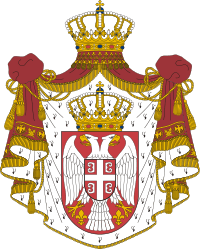 | ||||||||||||||||
|
||||||||||||||||
|
||||||||||||||||
|
||||||||||||||||
|
||||||||||||||||
|
||||||||||||||||
|
| ||||||||||||||||
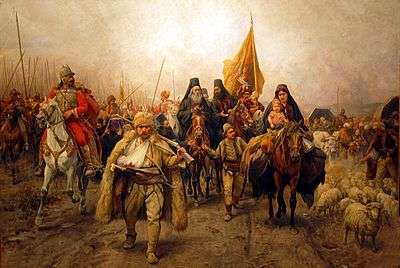
The First Great Migration occurred during the Habsburg-Ottoman War (1683-1699) under Serbian Patriarch Arsenije III Crnojević, and came as a result of the Habsburg retreat and Ottoman reoccupation of southern Serbian regions, which were temporarily held by the Habsburgs between 1688 and 1690.[3]
The Second Great Migration took place during the Habsburg-Ottoman War (1737-1739), under the Serbian Patriarch Arsenije IV Jovanović, also parallel with the Habsburg withdrawal from Serbian regions, which between 1718 and 1739 were known as the Kingdom of Serbia.[4]
The masses of earlier migrations from the Ottoman Empire are considered ethnically Serb, while those of the First Great Migration nationally Serb. The First Great Migration brought the definitive indicator of Serbianness, Orthodox Christianity and its leader, the patriarch.[5]
Background
Some Serbian historians, citing a document issued by Emperor Leopold I in 1690, claim that the masses were "invited" to come to Hungary. The original text in Latin shows that Serbs were actually advised to rise up against the Ottomans and "not to desert" their ancestral lands.[6][7]
First migration
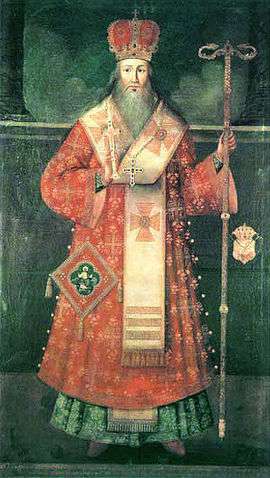
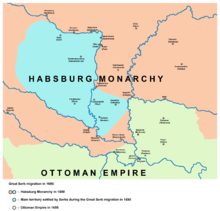
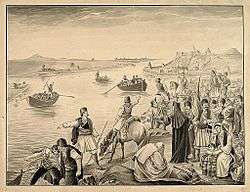
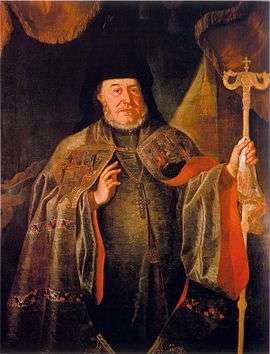
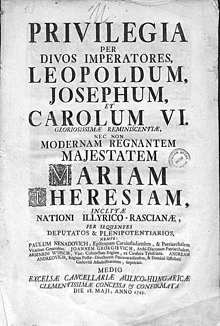
During the Austro-Turkish war (1683–1699) relations between Muslims and Christians in the European provinces of the Ottoman Empire were extremely radicalized. As a result of the lost rebellion and suppression, Serbian Christians and their church leaders, headed by Serbian Patriarch Arsenije III sided with the Austrians in 1689. Albanian Catholics were also part of the exodus.[8] They settled mainly in the southern parts of the Kingdom of Hungary. The most important cities and places they settled are Szentendre, Buda, Mohács, Pécs, Szeged, Baja, Tokaj, Oradea, Debrecen, Kecskemét, Szatmár.[9]
In 1690, Emperor Leopold I allowed the refugees gathered on the banks of the Sava and Danube in Belgrade to cross the rivers and settle in the Habsburg Monarchy. He recognized Patriarch Arsenije III Čarnojević as their spiritual leader.[10] The Emperor had recognized the Patriarch as deputy-voivode (civil leader of the migrants), which over time developed into the etymology of the northern Serbian province of Vojvodina[10] (this origin of the name of Vojvodina is related to the fact that patriarch Arsenije III and subsequent religious leaders of Serbs in the Habsburg Monarchy had jurisdiction over all Serbs in the Habsburg Monarchy, including Serbs of Vojvodina, and that Serbs of Vojvodina accepted the idea of a separate Serbian voivodeship in this area, which they managed to create in 1848).
In 1694, Leopold I, Holy Roman Emperor appointed Arsenije III Čarnojević as the head of the newly established Orthodox Church in the Monarchy.[11] The patriarchal right of succession was secured by the May Assembly of the Serbian people in Karlovci in 1848, following the proclamation of Serbian Vojvodina during the Serbian revolution in Habsburg lands 1848–49.[11] Serbs received privileges from the Emperor, which guaranteed them national and religious singularity, as well as a corpus of rights and freedoms in the Habsburg Monarchy.[11]
Second migration
The breakout of the Habsburg-Ottoman War (1737-1739) triggered the Second Great Migration of the Serbs. In 1737, at the very beginning of the war, Serbian Patriarch Arsenije IV Jovanović sided with Habsburgs and supported the rebellion of Serbs in the region of Raška against Ottomans. During the war, Habsburg armies and the Serbian Militia failed to achieve substantial success, and subsequently were forced to retreat. By 1739, entire territory of the Habsburg Kingdom of Serbia was lost to Ottomans. During the war, large portion of Christian population from the region of Raška and other Serbian lands migrated towards the north, following the retreat of Habsburg armies and the Serbian Militia. They settled mainly in Syrmia and neighbouring regions, within the borders of the Habsburg Monarchy which includes and Catholic Albanians, the Klimente who settled three villages in Syrmia.[4]
Number of migrants
Sources provide different data regarding the number of people in the first migration, referring to the group led by Patriarch Arsenije III:
- 37,000 families into Habsburg Monarchy, according to a manuscript at Šišatovac monastery written by monk Stefan of Ravanica 28 years after the first wave.[12]
- 37,000 families, according to a book by Pavle Julinac, printed in 1765.[13]
- 37,000 families led by the Patriarch, according to Jovan Rajić, published in 1794–95.[14]
- 37,000 families led by the Patriarch, according to Johann Engel, published 1801.[15]
- Émile Picot concluded that it was 35,000 to 40,000 families, between 400,000 and 500,000 people. "It is a constant tradition that this population is counted by families, not by heads" also insisting that these were large extended families (see Zadruga).[16]
- The Serbian Academy of Arts and Sciences, supports the figure of 37,000 families.[11]
- Tatjana Popović, cites as many as 60,000 Serbian migrant families for the First Serbian migration alone.[17]
- At least 30,000 people, according to Stevan K. Pavlowitch.[10]
- 20,000–30,000 people, according to "Teatri europei".[18]
- According to Noel Malcolm, two statements from Arsenije survive. In 1690 he wrote "more than 30,000 souls", and six years later he wrote that it was "more than 40,000 souls".[19] Malcolm also cites Cardinal Leopold Karl von Kollonitsch's statement from 1703 of more than 60,000 people led by the Patriarch from Belgrade to the Kingdom of Hungary, a figure Malcolm claims Kollonich may have been inclined to exaggerate.[19] According to Noel Malcolm, data that state that 37,000 families participated in this migration derive from a single source: a Serbian monastic chronicle which was written many years after the event and contains several other errors.[20]
- According to Sima Ćirković, the figure of 40,000 people is an exaggeration. He says that there is no testimony other than those of the Patriarch for a more reliable estimate.[21]
- Mikael Antolović studied articles by Ilarion Ruvarac who claimed that between 70,000-80,000 refugees left Kosovo during the migration, while the Serbian public claimed that it was more than half a million, and that the majority fled due to "fear of Ottoman vengeance".[22]
- Other historians state that only a few thousand refugees left during this time.[23]
Aftermath
Serbs from these migrations settled in the southern parts of the Hungary (though as far in the north as the town of Szentendre, in which they formed the majority of population in the 18th century, but to smaller extent also in the town of Komárom) and Croatia.
The large Serb migrations from Balkans to the Pannonian plain started in the 14th century and lasted until the end of the 18th century. The great migrations from 1690 and 1737–39 were the largest ones and were important reason for issuing the privileges that regulated the status of Serbs within Habsburg Monarchy. The Serbs that in these migrations settled in Vojvodina, Slavonia and the parts belonging to the Military Frontier[24] increased (partly) the existing Serb population in these regions and made the Serbs an important political factor in the Habsburg Monarchy over time.
The masses of earlier migrations from the Ottoman Empire are considered ethnically Serb, while those of the First Great Migration nationally Serb. The First Great Migration brought the definitive indicator of Serbianness, Orthodox Christianity and its leader, the patriarch.[25]
Modern analysis
The narrative about the migration is part of the Serbian identity narratives. It is a national-religious myth with a heroic theme.[26][7] Frederic Anscombe suggests that it, together with other narratives of the Kosovo myth, form the basis of Serbian nationalism and have fueled the conflicts.[27] According to Frederick Anscombe, the Great Migration reconciles romantic national history with late modern reality, portraying Albanians of Kosovo as descendants of Ottoman-sponsored transplants who settled after the expulsion of the Serb population and supposedly took over the control of the territory,[28] thus replaying of a "second Battle of Kosovo"[29] and continual struggle for freedom.[30] Malcolm and Elsie state that various migrations took place because of the War of the Holy League (1683-1699), when thousands of refugees found shelter on the new Habsburg border.[31][32] Saggau states that the modern adaptation and popularisation of the migration retrieves inspiration from Vuk Karadžić and Petar II Petrović-Njegoš, and prior to this, had not yet become a component of Serb national identity.[33] According to Maroš Melichárek, the migration has also been depicted with Serbian national symbolism. The famous painting by Paja Jovanović, commissioned in 1896 by Patriarch Georgije Branković[34] was compared with notable American painting by Emanuel Leutze Washington Crossing the Delaware.[35] The depiction and symbolism of Great Serbian migration is still very strong and up-to-date. History professor Maroš Melichárek mentions that other comparisons were made of the Great Migrations, such as to the Great Retreat and a photo of Serbs fleeing from Republika Srpska Krajina.[36] Among the refugees that moved to Austrian-dominated territories at the time there was also a substantial number of Albanians, both Eastern Orthodox and Catholic.[37] The topic of the Great Migrations is a source of disputes between some Serbian and Albanian historians, with each side having its viewpoint.[38] István Deák from the University of Colombia states that Serbs, who were somewhat better educated than the Albanians, were willing to move in search of better economic opportunities, which helped demographic changes in the territory of Kosovo throughout the centuries.[39]
References
| Wikimedia Commons has media related to Great Migrations of the Serbs. |
- Ćirković 2004, p. 143-148, 153-154.
- Гавриловић 2014, p. 139–148.
- Ćirković 2004, p. 143-148.
- Ćirković 2004, p. 153-154.
- Nicholas J. Miller (15 February 1998). Between Nation and State: Serbian Politics in Croatia Before the First World War. University of Pittsburgh Pre. p. 13. ISBN 978-0-8229-7722-3.
- Ramet 2005, p. 206.
- Noel Malkolm (2004). Kosovo: a chain of causes 1225 B.C. - 1991 and consequences 1991-1999. Helsinki Committee for Human Rights in Serbia. pp. 1–27.
- Malcolm, Noel. A Short History of Kosovo. p. 161.
- Maroš Melichárek, 2017, Great migration of the Serbs (1690) and its reflections in modern historiography, https://s3.amazonaws.com/academia.edu.documents/55351257/367693013-.pdf?response-content-disposition=inline%3B%20filename%3DGREAT_MIGRATION_OF_THE_SERBS_1690_AND_IT.pdf&X-Amz-Algorithm=AWS4-HMAC-SHA256&X-Amz-Credential=AKIAIWOWYYGZ2Y53UL3A%2F20200206%2Fus-east-1%2Fs3%2Faws4_request&X-Amz-Date=20200206T174437Z&X-Amz-Expires=3600&X-Amz-SignedHeaders=host&X-Amz-Signature=b08c45a63511e2fe7a409644cb1c39054fcc011e805068d1e52f611a0e74154e#page=88
- Pavlowitch 2002, p. 20.
- "Archived copy" (PDF). Archived from the original (PDF) on 2015-09-24. Retrieved 2010-01-09.CS1 maint: archived copy as title (link)
- Stanojevic, Ljubomir. (ed) Stari srpski zapisi i natpisi, vol 3, Beograd 1905, 94, no 5283: "37000 familija"
- Pavle Julinac, Kratkoie vredeniie v istoriiu proikhozhdeniia slaveno-serbskago naroda. Venetiis 1765 (ed. Miroslav Pantic, Belgrade, 1981), p. 156: numbers derived from an official Imperial report to Vienna.
- Jovan Rajić, Istoriia raznikh slavenskikh narodov, naipache Bolgar, Khorvatov, i Serbov, vol 4, 1795, p. 135: "37000 familii Serbskikh s Patriarkhom
- Engel, Johann Christian von, Geschichte des ungrischen Reichs und seiner Nebenländer, vol. 3. Halle 1801, 485: "37000 Serwische Familien, mit ihrem Patriarchen"
- A.E. Picot, Les Serbes de Hongrie, 1873, p. 75
- Popović 1988, p. 28.
- Aleksandar Protić, Još koja o istom, Seoba u sporovima, Novi Sad, 1991, page 91.
- Two written statements by Arsenije survive, specifying the number of people: at the end of 1690 he gave it as "more than 30,000 souls", and six years later he wrote that it was "more than 40,000 souls". These are the most authoritative statements we have... Noel Malcolm: Albanische Geschichte: Stand und Perspektiven der Forschung; by Eva Anne Frantz. p. 238
- Noel Malcolm, Kosovo - a short history, Pan Books, London, 2002, page 161.
- Sima M. Cirkovic (2004). The Serbs. Wiley. p. 144.
- Antolović, Michael (2016). "Modern Serbian Historiography between Nation-Building and Critical Scholarship: The Case of Ilarion Ruvarac (1832-1905)". The Hungarian Historical Review. 5 (2): 332–356. JSTOR 44390760.
- Máiz, Ramón; William, Safran (2014). Identity and Territorial Autonomy in Plural Societies. Routledge. ISBN 978-1-135-30401-0.
- https://ww1.habsburger.net/en/chapters/serbs-habsburg-monarchy#:~:text=In%201910%20the%20Serbs%20were,enjoy%20an%20absolute%20majority%20anywhere.
- Miller 1997, p. 13.
- J. M. Fraser (1998). International Journal. Canadian Institute of International Affairs. p. 603.
- Dan Landis; Rosita D. Albert (2012). Handbook of Ethnic Conflict: International Perspectives. Springer Science & Business Media. p. 351.
- Melichárek, 2017, (p.93)
- Frederick F., Anscombe (2006). The Ottoman Empire in recent international politics II: the case of Kosovo. The International History Review (PDF). Birkbeck ePrints: an open access repository of the research output of Birkbeck College. pp. 767, 769. Retrieved 30 March 2020.
- Melichárek, 2017, (p.93)
- Anscombe, ibid.
- Elsie, Robert (2004). Historical Dictionary of Kosova. Scarecrow Press. p. 71. ISBN 978-0-8108-5309-6. Retrieved 30 March 2020.
- Emil Hilton, Saggau (2019). Kosovo Crucified—Narratives in the Contemporary Serbian Orthodox Perception of Kosovo. University of Copenhagen: Department for Church History. pp. 6, 10, 11. Retrieved 30 March 2020.
- Tim, Judah. "washingtonpost.com: The Serbs". www.washingtonpost.com (The original painting was commissioned in 1896 by Patriarch Georgije Brankovic. The artist was Paja Jovanovic. He was one of the most illustrious Serbian painters of his generation and his depictions of the greatest moments of Serbian history placed him firmly at the centre of the national artistic renaissance of the time). Washington Post. Retrieved 30 March 2020.
- Melichárek, Maroš; Research, Serbian Studies. Maroš Melichárek, "GREAT MIGRATION OF THE SERBS (1690) AND ITS REFLECTIONS IN MODERN HISTORIOGRAPHY", Serbian Studies Research, vol. 8, no. 1, 2017, 87-102. pp. 88, 89. Retrieved 30 March 2020.
- Melichárek, Maroš; Research, Serbian Studies. Maroš Melichárek, "GREAT MIGRATION OF THE SERBS (1690) AND ITS REFLECTIONS IN MODERN HISTORIOGRAPHY", Serbian Studies Research, vol. 8, no. 1, 2017, 87-102. pp. 88, 89. Retrieved 30 March 2020.
- Lampe, John R.; Lampe, Professor John R. (2000). Yugoslavia as History: Twice There Was a Country "The first ottoman encouragement of Albanian migration did follow the Serb exodus of 1690". Cambridge University Press. p. 26. ISBN 978-0-521-77401-7. Retrieved 3 April 2020.
- Shinasi A. Rama (2019). Nation Failure, Ethnic Elites, and Balance of Power: The International Administration of Kosova. Springer. p. 64.
- Parker, Franklin; Parker, Betty June (2017). Education in the People's Republic of China, Past and Present (PDF) (In general, families, clans, and tribes moved, settled, converted, and reconverted in the Balkans; only in modern times have such acts become a major political issue. No doubt, the proportion of Albanian-speaking Muslims has increased in Kosovo over the centuries, so that today they form the overwhelming majority, but this was due, in part, to the willingness of local Serbs, somewhat better educated than the Albanians, to move away in search of better economic opportunities. ed.). p. 9. Retrieved 9 April 2020.
Sources
- Bataković, Dušan T., ed. (2005). Histoire du peuple serbe [History of the Serbian People] (in French). Lausanne: L’Age d’Homme. ISBN 9782825119587.CS1 maint: ref=harv (link)
- Ćirković, Sima (2004). The Serbs. Malden: Blackwell Publishing. ISBN 9781405142915.CS1 maint: ref=harv (link)
- Cox, John K. (2002). The History of Serbia. Westport, Connecticut: Greenwood Press. ISBN 9780313312908.CS1 maint: ref=harv (link)
- Đorđević, Života; Pejić, Svetlana, eds. (1999). Cultural Heritage of Kosovo and Metohija. Belgrade: Institute for the Protection of Cultural Monuments of the Republic of Serbia.CS1 maint: ref=harv (link)
- Гавриловић, Владан С. (2014). "Примери миграција српског народа у угарске провинцијалне области 1699-1737" [Examples of Serbian Migrations to Hungarian Provincial Districts 1699-1737]. Истраживања (in Serbian). Филозофски факултет у Новом Саду. 25: 139–148.CS1 maint: ref=harv (link)
- Ingrao, Charles; Samardžić, Nikola; Pešalj, Jovan, eds. (2011). The Peace of Passarowitz, 1718. West Lafayette: Purdue University Press. ISBN 9781557535948.CS1 maint: ref=harv (link)
- Ивић, Алекса (1914). Историја Срба у Угарској од пада Смедерева до сеобе под Чарнојевићем (1459-1690). Загреб.CS1 maint: ref=harv (link)
- Ивић, Алекса (1929). Историја Срба у Војводини од најстаријих времена до оснивања потиско-поморишке границе (1703). Нови Сад: Матица српска.CS1 maint: ref=harv (link)
- Ivić, Pavle, ed. (1995). The History of Serbian Culture. Edgware: Porthill Publishers.CS1 maint: ref=harv (link)
- Jelavich, Barbara (1983). History of the Balkans: Eighteenth and Nineteenth Centuries. 1. Cambridge University Press. ISBN 9780521274586.CS1 maint: ref=harv (link)
- Katić, Tatjana (2012). Tursko osvajanje Srbije 1690. godine [The Ottoman Conquest of Serbia in 1690.] (in Serbian). Beograd: Srpski genealoški centar, Centar za osmanističke studije.CS1 maint: ref=harv (link)
- Miller, Nicholas J. (1997). Between Nation and State: Serbian Politics in Croatia Before the First World War. Pittsburgh: University of Pittsburgh Press.CS1 maint: ref=harv (link)
- Pavlowitch, Stevan K. (2002). Serbia: The History behind the Name. London: Hurst & Company. ISBN 9781850654773.CS1 maint: ref=harv (link)
- Поповић, Душан Ј. (1950). Срби у Срему до 1736/7: Историја насеља и становништва. Београд: Српска академија наука.CS1 maint: ref=harv (link)
- Поповић, Душан Ј. (1952). Срби у Бачкој до краја осамнаестог века: Историја насеља и становништва. Београд: Научна књига.CS1 maint: ref=harv (link)
- Поповић, Душан Ј. (1954). Велика сеоба Срба 1690: Срби сељаци и племићи. Београд: Српска књижевна задруга.CS1 maint: ref=harv (link)
- Поповић, Душан Ј. (1955). Срби у Банату до краја осамнаестог века: Историја насеља и становништва. Београд: Научна књига.CS1 maint: ref=harv (link)
- Поповић, Душан Ј. (1957). Срби у Војводини: Од најстаријих времена до Карловачког мира 1699. 1. Нови Сад: Матица српска.CS1 maint: ref=harv (link)
- Поповић, Душан Ј. (1959). Срби у Војводини: Од Карловачког мира 1699 до Темишварског сабора 1790. 2. Нови Сад: Матица српска.CS1 maint: ref=harv (link)
- Popović, Tatyana (1988). Prince Marko: The Hero of South Slavic Epics. New York: Syracuse University Press. ISBN 9780815624448.CS1 maint: ref=harv (link)
- Ramet, Sabrina P. (2005). Thinking about Yugoslavia: Scholarly Debates about the Yugoslav Breakup and the Wars in Bosnia and Kosovo. Cambridge, UK: Cambridge University Press. ISBN 9780521616904.CS1 maint: ref=harv (link)
- Samardžić, Radovan (1989). "Migrations in Serbian History (The Era of Foreign Rule)". Migrations in Balkan History. Belgrade: Institute for Balkan Studies. pp. 83–89. ISBN 9788671790062.CS1 maint: ref=harv (link)
- Томић, Јован Н. (1902). Десет година из историје српског народа и цркве под Турцима (1683-1693) (PDF). Београд: Државна штампарија.CS1 maint: ref=harv (link)
- Трифуноски, Јован Ф. (1990). "Велика сеоба Срба у народним предањима из Македоније" [The Great Serbian Migration in Folk Legends from Macedonia] (PDF). Етнолошке свеске (in Serbian). 11: 54–61.CS1 maint: ref=harv (link)
- Živojinović, Dragoljub R. (1989). "Wars, Population Migrations and Religious Proselytism in Dalmatia during the Second Half of the XVIIth Century". Migrations in Balkan History. Belgrade: Institute for Balkan Studies. pp. 77–82. ISBN 9788671790062.CS1 maint: ref=harv (link)
External links
- Ćorović, Vladimir (2001) [1997]. "Velika seoba Srba u Austriju". Istorija srpskog naroda. Projekat Rastko.